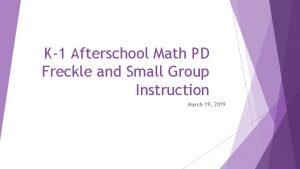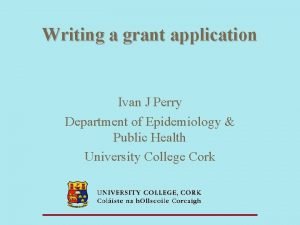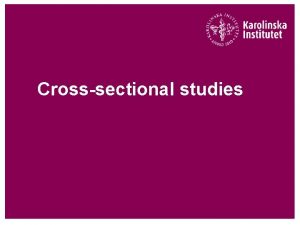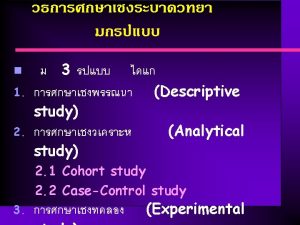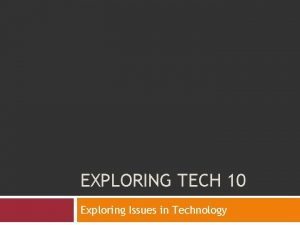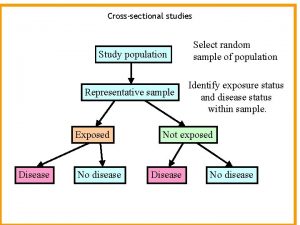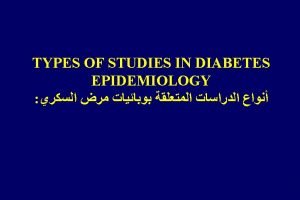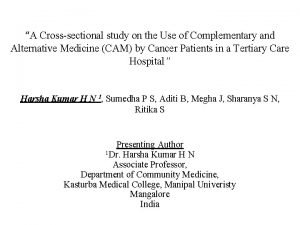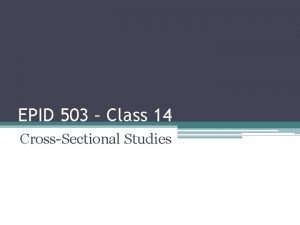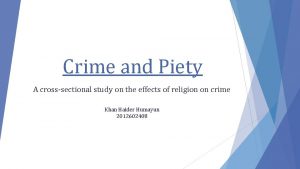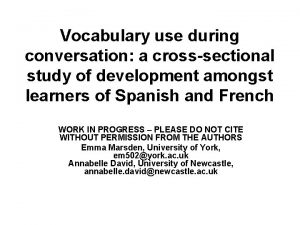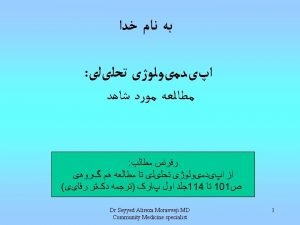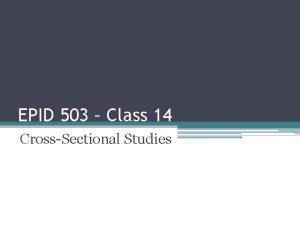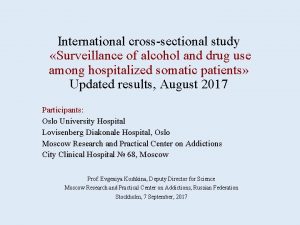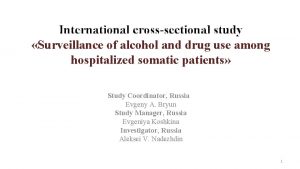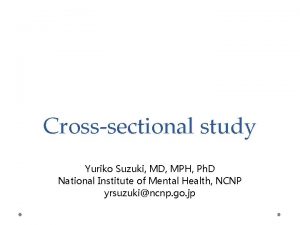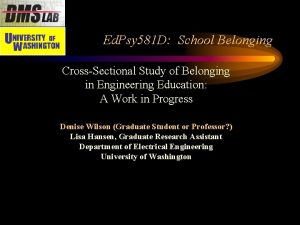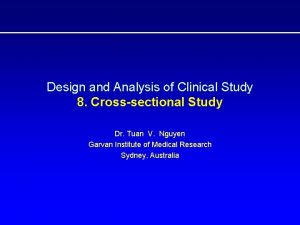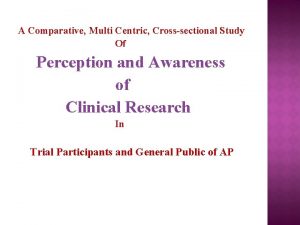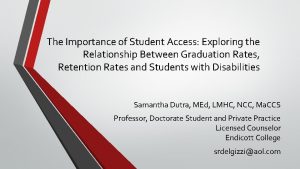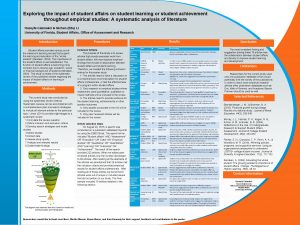A CrossSectional Study Exploring The Importance of Student



















































- Slides: 51

A Cross-Sectional Study Exploring: The Importance of Student Support Services, as Perceived by Nontraditional Students Enrolled in 4 -Year Public Institutions in South Texas Conducted by: Dr. Bridgette Everhart Hardin Texas A&M University- Corpus Christi

Presentation Outline The purpose of today’s presentation is to discuss the following: • Why was the research necessary? • The foundation and administration of the research. • What was discovered? • Why does it matter?

Why was the research necessary? Background A changing student composition in Higher Education: • NCES (2002): Undergraduate population different than a generation ago. • Choy (2002): More nontraditional students on campus.

Why was the research necessary? Background • The definition of a nontraditional student is expanding to include traditional aged students with nontraditional lives (Horn, 1996). • Nearly 75% of undergraduates, enrolled in American colleges or universities, can be defined as “nontraditional” in some way (The Chronicle of Higher Education, 2005, p. 26). Minimal Maximum

Why was the research necessary? Background US Dept. of Education Students 25 years or older, attending postsecondary education in the United States has increased from 28% in 1970 to 44% in 2004 (2005).

Why was the research necessary? Background THECB 2007 Enrollment Trend Analysis for its postsecondary institutions has indicated that nearly half of Texas resident students will be 25 or older in 2020.

Why was the research necessary? Background THECB 2007 Enrollment Trend Analysis for South Texas predicts an increase enrollment of 20% for nontraditional students (25 or older & first time in college) over the next 15 years.

Why was the research necessary? Background Many Texas Students have defined themselves as nontraditional in some way: • Data collected from the National Survey of Student Engagement, (2005) showed 44% of participating undergraduates enrolled in 4 -year public institutions in Texas were employed at least PT while attending college. • Additionally, 36% of the participating undergraduates, from the same institutions, identified themselves as caretakers of dependents while attending college (NSSE Report, 2005).

Why was the research necessary? Background South Texas factors to consider: • 40% of households comprised of families with children under 18 years of age (US Census Bureau, 2005); • 32% of households defined as single-parent families (US Census Bureau, 2005).

Why was the research necessary? Background South Texas factors to consider: • Employment rates for P/T & F/T combined were at 50% in south Texas for people ages 16 and older (Self Reported to US Census Bureau, 2005). • 20% increase in degree-required employment options for its residents over the next 15 years (Texas Workforce Commission, 2005).

Why was the research necessary? Background Economic Factors to Consider: • Demographic, economic, and technological developments” evolving from the “Knowledge Age” (Richardson & King, 1998, p. 65). • Need to be competitively desirable in the labor market (Wagner 2002).

Why was the research necessary? The Rising Problem Nontraditional students often experience: • Blind navigation through college (Cross, 1981; Dolly 1995; Kim, 2002). • Support services unavailable or inaccessible: although these students pay the same tuition and fees as their traditional & daytime counterpart (Scott-Summers, 1992). • Institutional resistance to change: adhering to a “traditional student campus model” (Tierney, 1998; Knowles, 1990).

Why was the research necessary? The Rising Problem • Increasing Demand on Minimal Supplies: Not enough nontraditional student structured services to meet the growing enrollment demands of this group. • Administrators need to find out what appropriate student support services are needed in order for their nontraditional student population to successfully navigate through college.

The foundation & administration of the research. Purpose of the Study To know the types of student support services nontraditional students of South Texas need to successfully navigate through their undergraduate career to graduation.

The foundation & administration of the research. Purpose of the Study This study addressed the following research questions through a survey from the perspective of freshman nontraditional students and senior nontraditional students currently enrolled in 4 year, public university undergraduate programs in South Texas:

The foundation & administration of the research. Purpose of the Study 1. On the basis of importance, what are the requirements for student support services, as perceived by nontraditional freshman students enrolled in south Texas 4 -year public institutions? 2. On the basis of importance, what are the requirements for student support services, as perceived by nontraditional senior students enrolled in south Texas four-year public institutions?

The foundation & administration of the research. Purpose of the Study 3. What is the difference between nontraditional freshmen and seniors, with respect to their perceptions of importance (aka- requirements) regarding student support services? 4. To what extent are nontraditional, undergraduate students support service needs met, as inferred by senior, nontraditional student response?

The foundation & administration of the research. Methodology of the Study • Cross-sectional study of nontraditional students in south Texas. – A cross-sectional study explores the relationship between different variables at a point in time, with analysis focusing on how variables affect each other at the same time (Meltzoff, 2004).

The foundation & administration of the research. The Literary Review Process • Historical forces influencing enrollment trends & changing demographics on campuses • Definitions & Characteristics describing nontraditional students. • Learning needs of nontraditional students. • Student support services needs of nontraditional students • Postsecondary institutional demands in meeting nontraditional student needs. • Relevance of Adult Education Research in Texas/ South Texas

The foundation & administration of the research. Theoretical Approach Andragogy (6 Core Principles) Learning needs of Adult Learners: • • Relevant, Locus of control, Impact personal experiences have on learning, Voluntary “readiness to learn” – Satisfy some purpose • Orientation to learning – problem-solving/ life-centered/ task-oriented, • Motivation/ intrinsic desire - Knowles (1978; 1990)

The foundation and administration of the research. Operational Definitions NONTRADITIONAL STUDENT**: 25 and older Age 25 when enrolled as a FR Delayed enrollment- 1 st X in college Limitation ‘Age’ was the primary criteria-matching characteristic used to identify the subjects for the study. ** More subjects could have been identified using Horn’s continuum (1996), the structure of the study mirrored that of prior adult education research studies, with 25 yrs serving as the “cut-off” (Houser, 2002).

The foundation & administration of the research. Operational Definitions REQUIREMENTS: Respondents' responses to the Nontraditional Student Support Services Needs Survey items were used to measure student perceptions regarding the importance and/or satisfaction of 1) academic guidance 2) educational planning, 3) career development, and 4) overall student development for successful navigation through their undergraduate career.

The foundation & administration of the research. Construct Definitions Academic Guidance: The area of student support that includes the following 1. Preparing the student for graduation or professional school 2. Providing student quality instruction and coursework 3. Providing adequate Faculty advising 4. Faculty related: Concern/ Respect for student 5. Faculty accessibility in and out of class

The foundation & administration of the research. Construct Definitions Educational Planning: The area of student support that includes the following 1. Educational programs to meet student skills & interests. 2. Knowledge on degree/graduation requirements 3. Knowledge on credit & non-credit acquisition by nontraditional means 4. Enrollment, Registration & Financial Aid processes 5. Accessibility to college offices after working hours 6. Knowledge of Library procedures 7. Knowledge of campus environment 8. Additional services: Child Care; Transportation; Disability Services

The foundation & administration of the research. Construct Definitions Career Development: The area of student support that includes the following 1. Identify individual strengths and abilities; matching to career areas. 2. Knowledge of job opportunities (FT/ PT) in career interest areas. 3. Acquisition of job opportunities (FT/PT) in career interest areas. 4. Learning how to find job opportunities/ how to interview 5. Learning how to create resumes/ vitas. 6. Learning about income potentials in career interest areas.

The foundation & administration of the research. Construct Definitions Overall Student Development: The area of student support that includes the following 1. Acquisition of a variety of skills: Math; Computer Literacy; Diversity; Ethics; Liberal Arts; Politics; Economics 2. Reading and writing clear and correct English. 3. Developing a commitment to personal health & fitness.

The foundation & administration of the research. Target Population Nontraditional students enrolled in 5 universities of the South Texas/ Rio Grande Region. FR: n= 317 SR: n= 2620

The foundation & administration of the research. Sample Selection • Performed a proportionate, stratified random sampling procedure to obtain the *criteria-matching student participant group for the study. • This technique: – guaranteed a sample proportionate to known sizes in the population of interest, and – confidence intervals tend to be narrower in studies employing stratified sampling procedures than studies employing simple random sampling procedures of the same population (Fink, 2002). *Criteria-Matching: 25 and older in freshman year.

Sample Selection

The foundation & administration of the research. Sample Limitations • The maximum collected sample was limited to 600 students, as per the questionnaire use agreement made with the ACT Incorporated. • The results from the questionnaire administered may have been influenced/ limited by: – willingness of the participants to state their perceptions in their responses; – degree of accuracy and the opinions offered by the participating students; – regional cultures; – institutional structures re: support services offered to NTS= Nontraditional Student

The foundation & administration of the research. Instrumentation Nontraditional Student Support Services Needs Online Survey Constructs Measured: 10 items* Academic Guidance 14 items** Educational Planning 10 items** Career Development 9 items* Overall Student Development 9 items Demographics Permission to use instrument items from: *Graduating Student Survey- Texas A&M Corpus Christi **Adult Learner Needs Assessment- ACT Incorporated

The foundation & administration of the research Instrumentation Nontraditional Student Support Services Needs Survey: Demographic Questions: – Gender – Age – Ethnicity – Class level – First-generation Status – Financial Aid History – GPA – Awareness of various “student support services” – Use of various “student support services”

The foundation & administration of the research. Assumptions • Participants of this study provided accurate and forthright responses on the questionnaire, while demonstrating knowledge about the topic of study. • Student sampling was representative of the nontraditional student age group and enrollment status of undergraduate level freshman students and senior students currently enrolled in south Texas.

The foundation & administration of the research. Data Collection Prior to conducting the formal research for this study, the researcher Pilot tested the instrument. – Established Content Validity: the instrument reviewed by a panel of experts, knowledgeable in the field of student support services and adult learning theory; – Established Internal Consistency/ Reliability: Cronbach’s Alpha =. 81 (43 items of importance) Cronbach’s Alpha =. 71 (43 items of satisfaction)

The foundation & administration of the research. Data Collection As part of the formal study: • Solicitation and reminder through E-mail invitation. • E-mail included a hyperlink to the web-based survey. • Participants were properly informed of voluntary participation in the study (electronic signature and completion of survey). • Data collection conducted from April 1, 2007 - April 8, 2007

The foundation & administration of the research. Data Collection NTS Freshmen and NTS Seniors answered: • 43 study-specific questions, rating level of importance to each item. • 9 demographic questions NTS Seniors also provided : • level of satisfaction responses to studyspecific items. NTS= Nontraditional Student

What was discovered? Data Analysis • The data were securely collected on-line and exported into the Statistical Package for Social Sciences 14. 0 (SPSS) for the purpose of data analysis. • Descriptive statistics were used to summarize and organize all variables in the study. • Inferential statistics were used to compare NTS freshman & NTS senior groups on the basis of variables of interest, as well as to compare importance & satisfaction measures of NTS seniors with regard to student support services. NTS= Nontraditional Student

Data Analysis 70% of maximum allowable

What was discovered? Data Analysis All participants ranked items on the basis of importance using a Likert-type scale: 4= Very Important 3= Important 2= Somewhat Important 1= Not Important

Data Analysis

What was discovered? Data Analysis The mean of study-specific items of each construct was used to measure the constructs. Cronbach’s coefficient alpha was used to estimate the internal consistency/reliability of each of the study-specific section’s scaled scores: Academic Guidance= Educational Planning= Career Development= Overall Student Development= . 80. 89. 90. 80

What was discovered? Data Analysis • Since the four study-specific sections were correlated (p<. 01), MANOVA was used to compare the two groups on the basis of their centroids. – A centroid is the mean of the vectors for each group. – A vector is a mathematical expression representing each subject’s scores on multiple response variables. – MANOVA is used to differentiate among groups with respect to their centroids (Stevens, 2002). • The level of significance was set at. 05 for the MANOVA.

What was discovered? Data Analysis • In spite of uneven sample sizes, the Box’s M test of equality of covariance matrices was not statistically significant: Box’s M= 6. 63, p=. 78. • Additionally, Homogeneity of Variance Assumption was met for each of the four construct scores.

What was discovered? Data Analysis • MANOVA showed that the difference between the two groups was not statistically significant: Wilks’ Lambda= 1. 00, F (4, 416) =. 35, p=. 85. • Mean difference effect sizes (Cohen’s d) were computed to assess the practical significance of the findings. Effect size was small for all 4 constructs (d=<. 2)

What was discovered? Data Analysis In addition to rating items based on importance, NTS seniors rated items on the basis of satisfaction, using the following Likert-type scale: 4= Very Satisfied 3= Satisfied 2= Somewhat Satisfied 1= Not Satisfied NTS= Nontraditional Student

What was discovered? Data Analysis Cronbach’s coefficient alpha was used to estimate the internal consistency/reliability of each of the study-specific section’s scaled scores (Gall, Gall and Borg, 2007): Academic Guidance= Educational Planning= Career Development= Overall Student Development= . 92. 93. 95. 90

What was discovered? Data Analysis • NTS Senior satisfaction responses were compared NTS Senior importance responses. • Comparison of importance to satisfaction of the NTS Senior student group was done by performing a series of t-tests for correlated samples. • The results were statistically significant across all four constructs at p<. 001. NTS= Nontraditional Student

Data Analysis

Why does it matter? Significance of the Study • Nontraditional students who are satisfied with their institution’s support services have higher retention rates and graduation rates than their unsatisfied counterparts (Aslanian, 2001; Astin, 1975). • With the results of this study, higher education Administrators can use the study’s findings to aid them in: – Formation Nontraditional Student – Implementation Support Services – Revision

Why does it matter? Significance of the Study Results of this study could provide valuable insight regarding the needs of nontraditional students to higher education Administrators involved in the strategic planning process for: • Cultivating a nontraditional student-centered learning environment • Recruitment of “continuum” nontraditional students • Retention after the first-year • Matriculation cycles

Questions?
 Chapter 2 exploring the americas study guide
Chapter 2 exploring the americas study guide How did you...your last weekend
How did you...your last weekend What did you do in london last weekend
What did you do in london last weekend Uheaa contact
Uheaa contact Class maths student student1 class student string name
Class maths student student1 class student string name National student clearinghouse student tracker
National student clearinghouse student tracker Freckle.student.com
Freckle.student.com Good morning students how are you today
Good morning students how are you today Student learning soace
Student learning soace Hát kết hợp bộ gõ cơ thể
Hát kết hợp bộ gõ cơ thể Slidetodoc
Slidetodoc Bổ thể
Bổ thể Tỉ lệ cơ thể trẻ em
Tỉ lệ cơ thể trẻ em Chó sói
Chó sói Glasgow thang điểm
Glasgow thang điểm Hát lên người ơi
Hát lên người ơi Môn thể thao bắt đầu bằng từ đua
Môn thể thao bắt đầu bằng từ đua Thế nào là hệ số cao nhất
Thế nào là hệ số cao nhất Các châu lục và đại dương trên thế giới
Các châu lục và đại dương trên thế giới Công thức tính thế năng
Công thức tính thế năng Trời xanh đây là của chúng ta thể thơ
Trời xanh đây là của chúng ta thể thơ Cách giải mật thư tọa độ
Cách giải mật thư tọa độ Làm thế nào để 102-1=99
Làm thế nào để 102-1=99 độ dài liên kết
độ dài liên kết Các châu lục và đại dương trên thế giới
Các châu lục và đại dương trên thế giới Thể thơ truyền thống
Thể thơ truyền thống Quá trình desamine hóa có thể tạo ra
Quá trình desamine hóa có thể tạo ra Một số thể thơ truyền thống
Một số thể thơ truyền thống Cái miệng nó xinh thế chỉ nói điều hay thôi
Cái miệng nó xinh thế chỉ nói điều hay thôi Vẽ hình chiếu vuông góc của vật thể sau
Vẽ hình chiếu vuông góc của vật thể sau Thế nào là sự mỏi cơ
Thế nào là sự mỏi cơ đặc điểm cơ thể của người tối cổ
đặc điểm cơ thể của người tối cổ Thứ tự các dấu thăng giáng ở hóa biểu
Thứ tự các dấu thăng giáng ở hóa biểu Vẽ hình chiếu đứng bằng cạnh của vật thể
Vẽ hình chiếu đứng bằng cạnh của vật thể Fecboak
Fecboak Thẻ vin
Thẻ vin đại từ thay thế
đại từ thay thế điện thế nghỉ
điện thế nghỉ Tư thế ngồi viết
Tư thế ngồi viết Diễn thế sinh thái là
Diễn thế sinh thái là Các loại đột biến cấu trúc nhiễm sắc thể
Các loại đột biến cấu trúc nhiễm sắc thể Các số nguyên tố
Các số nguyên tố Tư thế ngồi viết
Tư thế ngồi viết Lời thề hippocrates
Lời thề hippocrates Thiếu nhi thế giới liên hoan
Thiếu nhi thế giới liên hoan ưu thế lai là gì
ưu thế lai là gì Khi nào hổ mẹ dạy hổ con săn mồi
Khi nào hổ mẹ dạy hổ con săn mồi Khi nào hổ mẹ dạy hổ con săn mồi
Khi nào hổ mẹ dạy hổ con săn mồi Hệ hô hấp
Hệ hô hấp Từ ngữ thể hiện lòng nhân hậu
Từ ngữ thể hiện lòng nhân hậu Thế nào là mạng điện lắp đặt kiểu nổi
Thế nào là mạng điện lắp đặt kiểu nổi Importance of the study example
Importance of the study example






